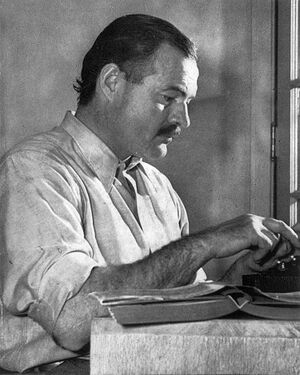Ernest Hemingway
 | |
| Born | Ernest Miller Hemingway 1899-07-21 Oak Park, Illinois, United States |
| Died | 1961-07-02 (Age 61) Ketchum, Idaho, U.S. |
Cause of death | gunshot |
| Children | • Jack • Patrick • Gregory |
| Spouse | Elizabeth Hadley Richardson |
| Member of | Office of Strategic Services |
| Victim of | premature death |
American author hounded by the FBI | |
Ernest Miller Hemingway was an American novelist, short-story writer, journalist, and sportsman. His economical and understated style—which he termed the iceberg theory—had a strong influence on 20th-century fiction, while his adventurous lifestyle and his public image brought him admiration from later generations. Hemingway produced most of his work between the mid-1920s and the mid-1950s, and he was awarded the Nobel Prize in Literature in 1954. He published seven novels, six short-story collections, and two nonfiction works. Three of his novels, four short-story collections, and three nonfiction works were published posthumously. Many of his works are considered classics of American literature.
Suicide
At age 60, Hemingway looked tired and old. He drank more than ever and suffered bouts of manic outbursts followed by deep depression. On July 2, 1961, he had gotten up early as usual, got dressed, but did not go to his writing room at his home in Idaho where his typewriter was located. Instead, he took out his favorite double-barreled shotgun Boss & Co. from the armory in the basement, loaded it with two heavy-bore bullets and went up the hall, where he put the barrel in his mouth and pulled the trigger. He wasn't the only one in his family to commit suicide. His father (Clarence), brother (Leicester), sister (Ursula) and his granddaughter Margaux died in the same way. Hemingway was given a Catholic funeral because the church ruled that he must not have been in his right mind at the time of his suicide. He was buried in Ketchum, Idaho.
Targeted the FBI
There are several theories about Ernest Hemingway's suicide. The most common theory is that he fell into a deep depression, realizing that his literary heyday were forever behind him. Writing was also physically difficult for him after the many trauma he suffered in the accidents. Hemingway may have suffered from the same genetic blood disease (hemochromatosis) as his father, with the inability to metabolize iron culminating in mental and physical deterioration. Several doctors had urged him to especially stop drinking, but Hemingway had ignored this advice. He had been treated with electroshock several times at the Mayo Clinic of Minnesota, but the depression kept coming back.
After these treatments, Hemingway began to show symptoms of dementia and paranoia. One of those alleged delusions was that the FBI was targeting him and having him tracked. However, Hemingway had in fact been under surveillance by the FBI since the 1940s because of his contacts and links with Cuba, as evidenced by the release of an FBI file in 1983[1] (120 pages, 15 of them largely blacked out for national security reasons.)[2]) The surveillance increased toward the end of his life.
Hemingway returned to the United States from Cuba the year before his suicide at the age of 61 under pressure from the US authorities. During a meeting with s friend, AE Hotchner, in 1960, Hemingway shared how the FBI shadowed him. His bank account was inspected, his phone bugged and his mail intercepted regularly, and sometimes, when he was sitting in a bar, he recognized FBI agents. Hotchner also relates how Hemingway called him from his hospital room and said that microphones had been placed in his room and that the telephone was tapped.
In November 1960, Hotchner writes in his biography[3], he had gone to visit Hemingway and Mary in Ketchum, Idaho, for an annual pheasant shoot. Hemingway was behaving oddly, Hotchner recalls: "When Ernest and our friend Duke MacMullen met my train at Shoshone, Idaho, for the drive to Ketchum, we did not stop at the bar opposite the station as we usually did because Ernest was anxious to get on the road. I asked why the hurry. 'The Feds.'
"'What?'
"'They tailed us all the way. Ask Duke.'
"'Well... there was a car back of us out of Hailey.'
"'Why are FBI agents pursuing you?' I asked.
"'It's the worst hell. The goddamnedest hell. They've bugged everything. That's why we're using Duke's car. Mine's bugged. Everything's bugged. Can't use the phone. Mail intercepted.'
"We rode for miles in silence. As we turned into Ketchum, Ernest said quietly: 'Duke, pull over. Cut your lights.' He peered across the street at a bank. Two men were working inside. 'What is it?' I asked. 'Auditors. The FBI's got them going over my account.'
"'But how do you know?'
"'Why would two auditors be working in the middle of the night? Of course it's my account'."
Related Document
| Title | Type | Publication date | Author(s) | Description |
|---|---|---|---|---|
| Document:The Mysterious Deaths of Ernest Hemingway and Iris Chang | article | 1 August 2011 | Darrell Hamamoto |